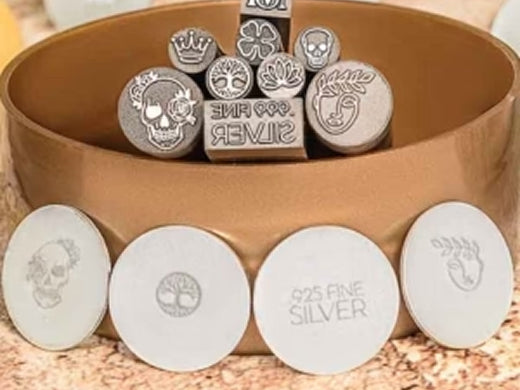
Engraving Depth for Custom Stamps: What You Need to Know for Leather, Wood, and Metal
Share
When ordering a custom metal stamp, one crucial detail is often overlooked — the engraving depth. Whether you're stamping leather, wood, or metal, choosing the correct depth can significantly affect your imprint quality and the durability of the stamp.
Let’s break down how engraving depth varies depending on material and application, and how it impacts the performance of your custom stamp.
Engraving Depth for Leather and Wood Stamping
Soft surfaces like leather and wood require deeper engraving — typically around 2 mm.
-
Why deeper?
-
Leather and wood absorb pressure, so a shallow design may leave a weak or blurred imprint.
-
Deeper engraving prevents the background or backing plate from being imprinted unintentionally.
-
It also helps create bold, clean lines when branding wooden products or personalizing leather goods.
-
Ideal for: Leathercraft, wood branding irons, custom logos on packaging or products.
Engraving Depth for Blacksmith Stamps
For blacksmith stamps used on hot or cold metal surfaces, the optimal engraving depth is between 1.0 and 1.4 mm.
-
Why not deeper?
-
Excessive depth on small, detailed designs may weaken thin elements and cause them to chip under pressure.
-
Metals require precision and balance — too deep, and the stamp may become fragile or difficult to use effectively.
-
Ideal for: Knife makers, forging logos, tool branding.
Engraving Depth for Standard Impact Stamps
Standard impact stamps (struck by hand with a hammer) typically feature an engraving depth of around 1 mm.
-
Reason:
-
The human hand can only apply a limited amount of force.
-
A deeper engraving would serve no practical benefit and could lead to unnecessary production complexity or tool wear.
-
Ideal for: General metal marking, handcrafted logos, cold stamping processes.
Why Engraving Depth Matters
Choosing the proper engraving depth is more than a technical detail — it defines the clarity, consistency, and lifespan of your stamp. Whether you're using a custom branding iron, a blacksmith stamp, or a leather marking tool, correct depth ensures:
-
Clean impressions without background bleed
-
Longer-lasting engraving without chipping
-
A better stamping experience with less effort
Conclusion
Metal stamping and custom engraving require a thoughtful balance of material, force, and design. By selecting the proper engraving depth for your application — whether on leather, wood, or metal — you ensure that your stamp produces consistently professional results.
Need expert advice on choosing the best depth for your next custom stamp? Visit MyStamps.store to order precision-made stamps tailored to your needs.